Istanbul is a large Turkish city, whose architecture and culture are intertwined with different eras, which makes Istanbul one of the most interesting and visited cities in the world.
Istanbul is full of sights and interesting places, some of which the city has inherited since the time of the sultans.
Palaces are singled out as a separate and one of the most important categories of Istanbul's attractions, some of which today are museums with recreated interiors, while others are adapted to the needs of the city or are in a ruined state - only parts of the palaces remain.
This article lists all the palaces and palace pavilions in Istanbul. If you need a list of only the best palace-museums with recreated interiors and household items that you can visit, then you can look here →
You can see and (or) visit the palaces of Istanbul on your own or with city tours
The best palaces in Istanbul
The best palaces in Istanbul include the main former sultan's residences, which are now museums with recreated interiors and adjacent park areas.
These palaces are worth visiting first of all, or if you have little time for Istanbul.
Topcaps
The Topkapi Palace (Topkapı Sarayı) served for 400 years as the main residence of the sultans of the Ottoman Empire, as well as the administrative and educational center of the state, until Sultan Abdul-Majida I moved to the newly built Dolmabahce Palace (Dolmabahçe Sarayı).
Today, the former Topkapi Palace is one of the main attractions of Istanbul, a magnificent architectural monument of the 15th-19th centuries and is a complex surrounded by high walls. The Topkaps include: courtyards and the palace complex itself with an administrative part and a harem, as well as other buildings and panoramic terraces. Also in the complex is the Church of St. Irene.
Entrance to the palace and the Church of St. Irene is paid.
Topkaps are located in the old historical part of the city, in the European part of Istanbul, at the address: Cankurtaran Mh., 34122 Fatih / Istanbul.
Topkapi Palace website: topkapi-sarayi. More about Topkapi Palace...
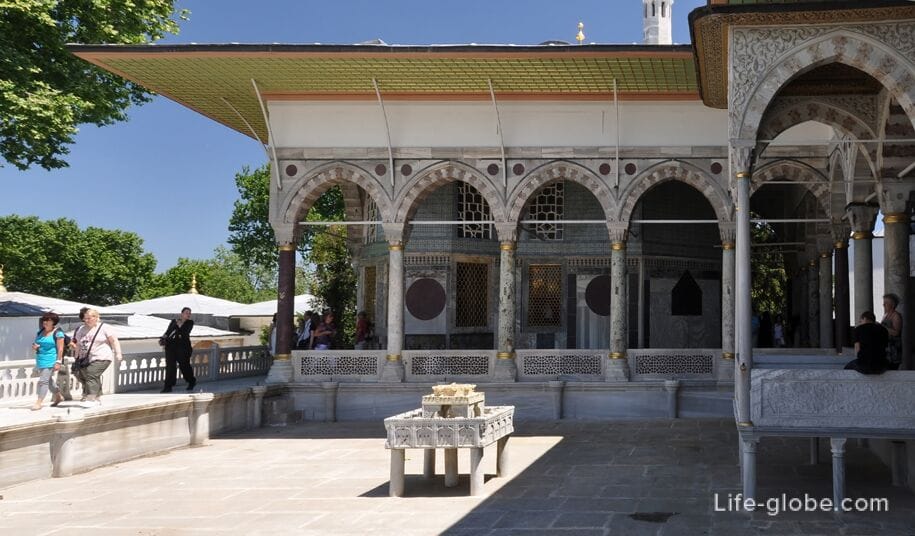

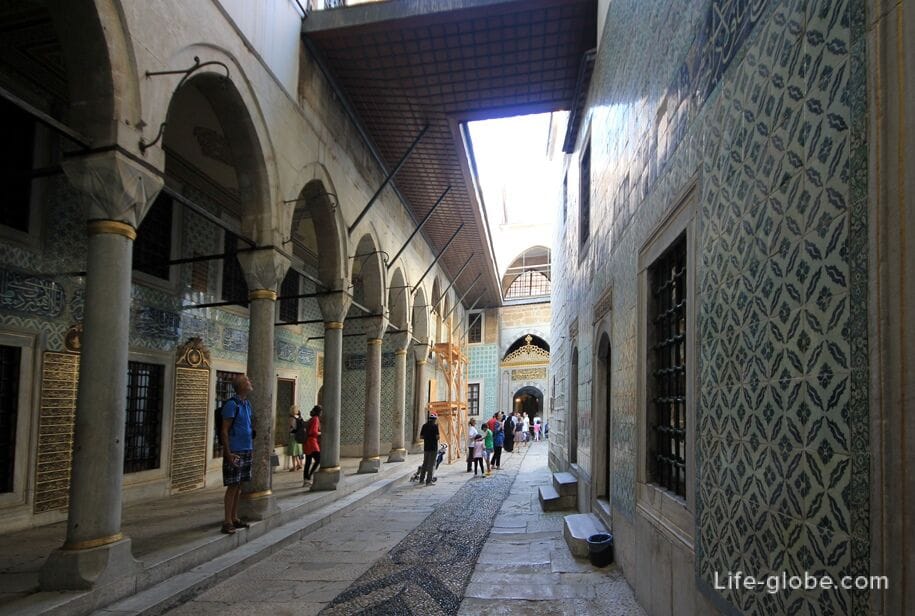
Near the walls of the Topkapi Palace there is a large Gulhane Park, which was the former outer park of the Topkapi Palace.
Today it is a public park with places for walking and recreation, cafes, fountains, monuments, historical sites and museums.
Entrance to the park is free. Learn more about Gulhane Park...

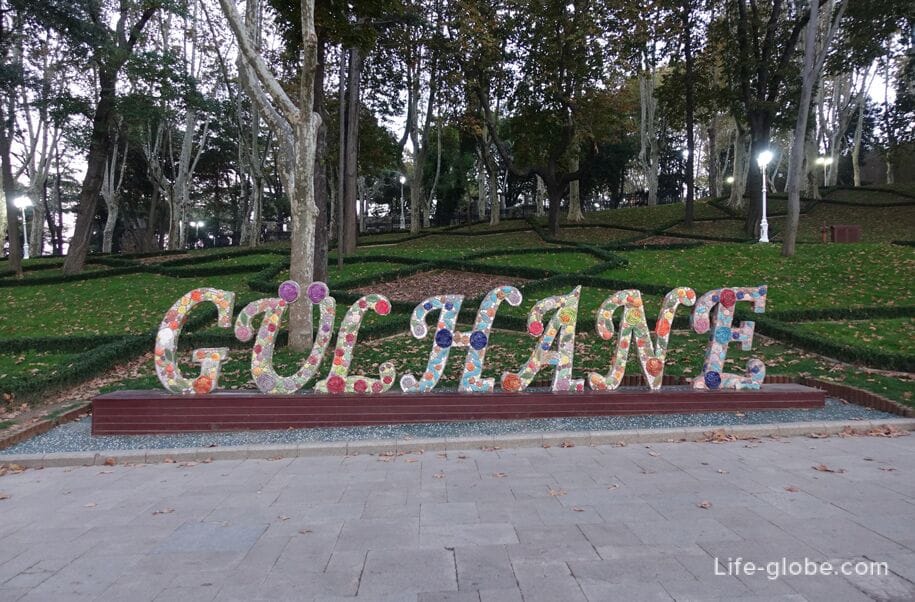
Dolmabahce
Dolmabahce (Dolmabahçe Sarayı) is a magnificent palace complex of the 19th century, which served as the residence of the Ottoman sultans.
Dolmabahce Palace was built in 1843-1853 by order and for Sultan Abdul-Majid I, who considered the Topkapi Palace operating at that time to be out of date, and wanted to erect a new palace for permanent residence, which in architecture and luxury would not be inferior to the exquisite European residences of influential people.
Today, the Dolmabahce Palace is a Museum where you can visit the garden overlooking the waters of the Bosphorus Palace rooms, consisting of: official public part of the "Selamlik" (Selamlık) with function hall (Tören Salonu), Harem (the Harem), or the family part of it; and the clock Museum and the Museum of painting and sculpture (Resim ve Heykel Müzesi).
Entrance to the palace is paid.
The palace is located on the European side of Istanbul by the waters of the Bosphorus, at the address: Vişnezade, Dolmabahçe Cd., 34357 Beşiktaş/Istanbul, Turkey.
Dolmabahce Palace website: dolmabahce-sarayi. More about Dolmabahce Palace...
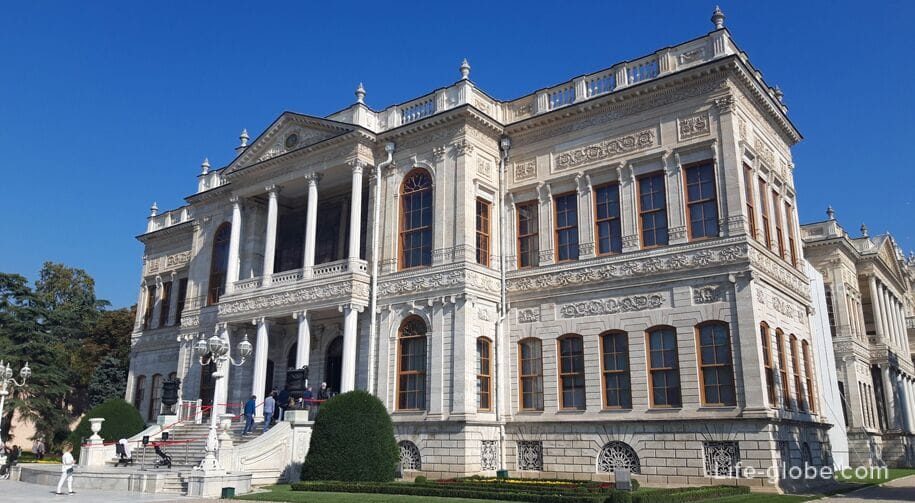
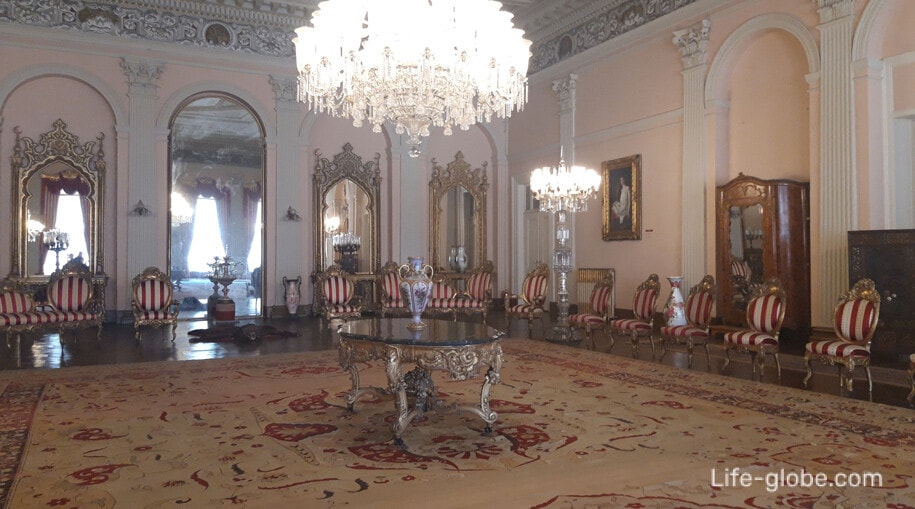
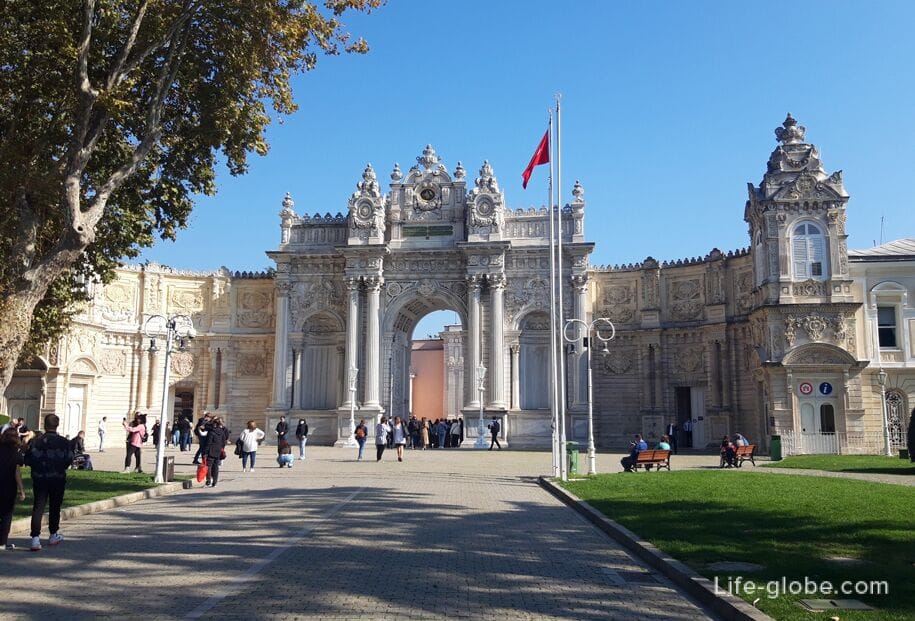
Museum of Palace Collections
The Museum of Palace Collections (Saray Koleksiyonları Müzesi) is located in the building of the former kitchens of the Dolmabahce Palace and was created by transferring about 20,000 items that the visitor could not see in the furnished rooms of the Dolmabahce Palace.
The main theme of the Museum of Palace Collections is to identify original objects that were used in everyday life in the Ottoman palaces of the 19th century, especially in the Dolmabahce Palace, and in the inventory of national palaces, and make them open to visitors.
Among the exhibited objects: clothing princes and princesses, toys, Handicrafts, stationery used by the sultans, print, epitaphs, samples writing utensils used in the Parliament and the first Grand national Assembly of Turkey, medication, dentist office, shaving sets of silver belonging to the sultans, equipment for cleaning and maintenance of Valide sultans, dishes made of crystal, porcelain and silver, manuscripts of the Koran, carpets Hereke, porcelain Yildiz, watches, porcelain furnace, books from the Palace library, drawing tools and materials belonging to the Caliph Abdulmecid Efendi, a collection of oil paintings, lighting and decorative tools.
Entrance to the museum is paid. It is paid separately from the entrance to the Dolmabahce Palace.
Museum address: Vişnezade, Dolmabahçe Cd., 34357 Beşiktaş/Istanbul, Turkey.
Museum website: saray-koleksiyonlari-muzesi.
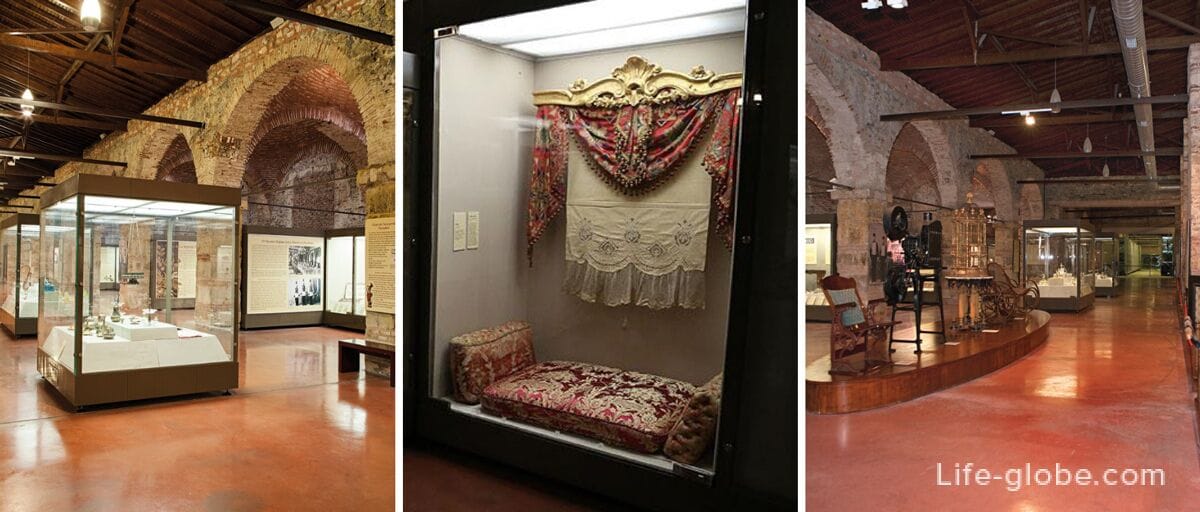
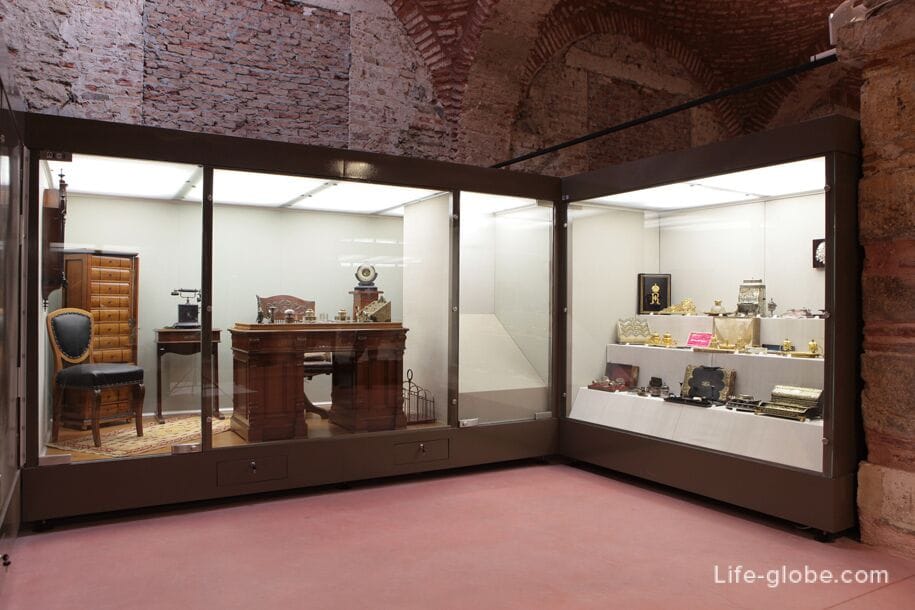
Beylerbeyi
The Beylerbeyi Sarayı Palace is a 19th-century neo-Baroque palace that served as a summer residence and accommodation for high-ranking guests of the sultans of the Ottoman Empire.
The first wooden palace on the current site, known as the "Divergent Garden", was erected by order of Sultan Mahmud II in 1808-1839. After the destruction of the wooden building due to a fire, by order of Sultan Abdul-Aziz in 1863-1865, a new palace was erected, which acquired its current appearance.
Since 1912, the palace was the last residence of the deposed Sultan Abdulhamid II. Within the walls of the palace, the Sultan died in 1918.
Today the palace is a museum, which is a palace complex, which includes the main building of the palace with recreated interiors, as well as the surrounding garden with terraces, pavilions, sculptures, a fountain and a cafe.
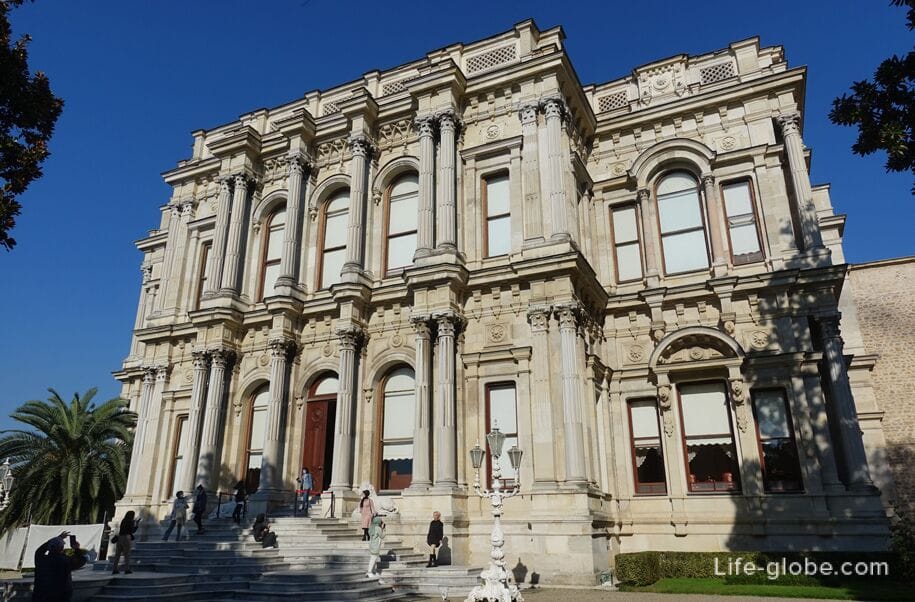
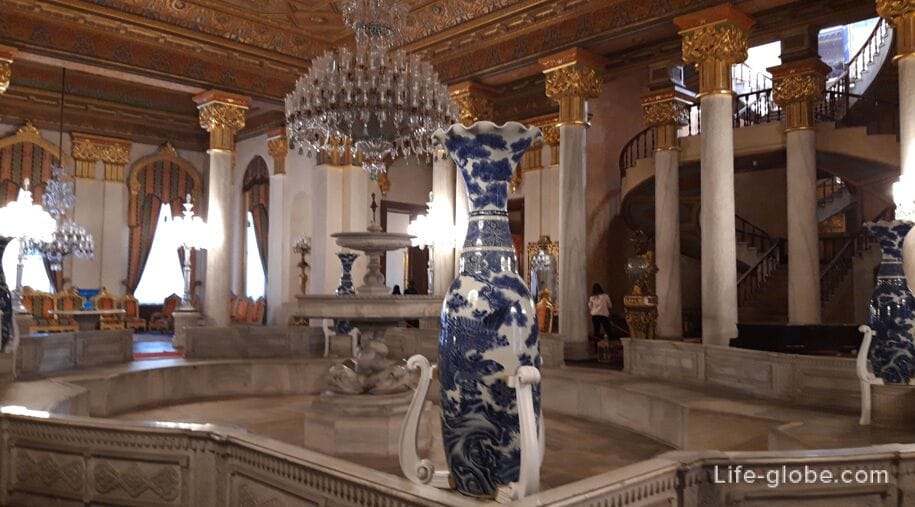
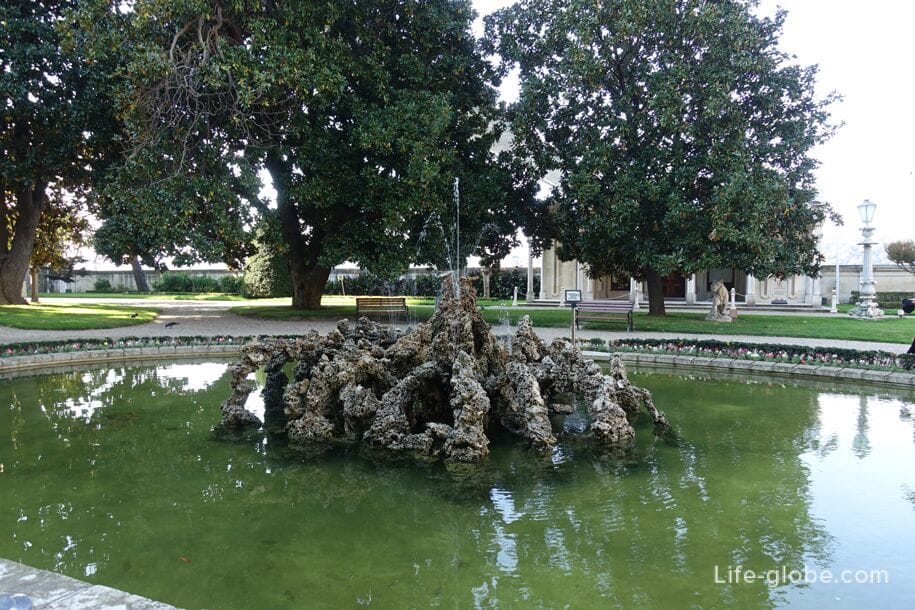
The gardens of the Beylerbeyi Palace also attract attention by the fact that they have access to a terrace near the waters of the Bosphorus, which is used as an observation deck.
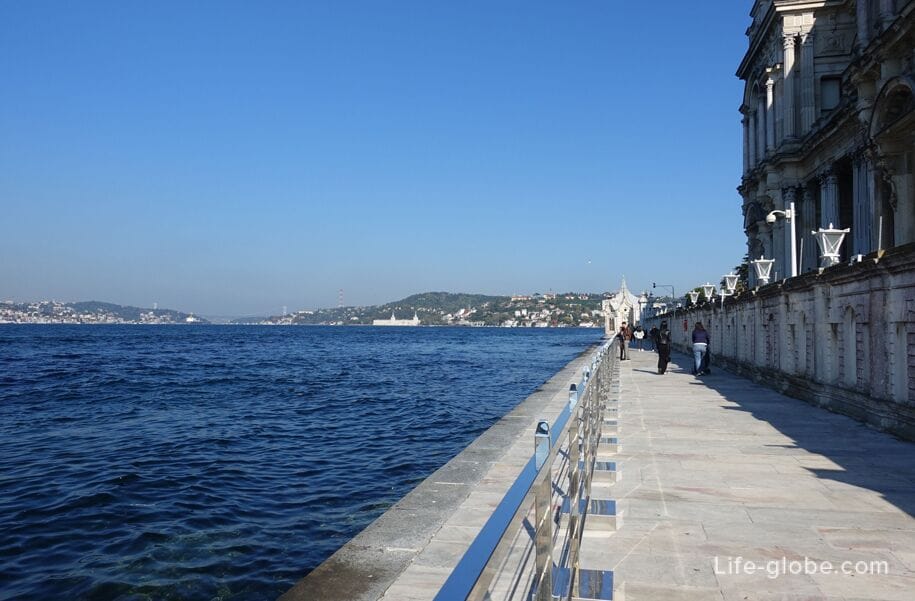
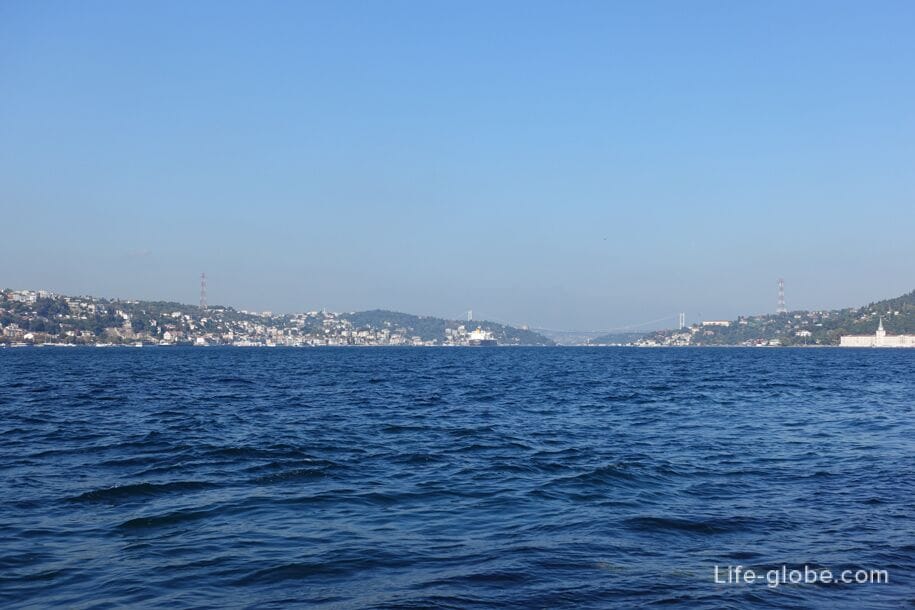
Entrance to the Beylerbeyi Palace is paid.
Beylerbeyi Palace with gardens is located in the Asian part of Istanbul, at the address: Beylerbeyi, Abdullahağa Cd., Istanbul.
Beylerbeyi Palace website: beylerbeyi-sarayi. More about the Beylerbeyi Palace with gardens and a terrace by the Bosphorus Strait...
Kyuchyuksu
The Palace of Küçüksu or Geksu Kasry (Küçüksu Kasrı) is a neo-Baroque palace, which, like the Beylerbeyi Palace (only Küçüksu is smaller in size) served as the summer residence of the sultans of the Ottoman Empire, and today is a museum with palace halls.
Translated from Turkish, the palace is called as "The Palace of Heavenly Water" or "The Palace of small water".
This miniature neo-Baroque palace was built in 1857 by order of Sultan Abd-ul-Majid I. The construction of the palace was carried out on the site of a two-story wooden palace built during the reign of Mahmud I.
Today, the Kyuchuksu Palace is a striking monument of the Ottoman Empire and functions as a museum with recreated palace interiors.
Entrance to the palace is paid.
The Kucuksu Palace is located in the Asian part of Istanbul, near the waters of the Bosphorus Strait, in Geksu district (Göksu), at: Göksu, Küçüksu Cd., 34810 Beykoz/Istanbul, Turkey.
The website of the Palace of Kucuksu: kucuksu-kasri. More about the Kyuchuksu Palace...

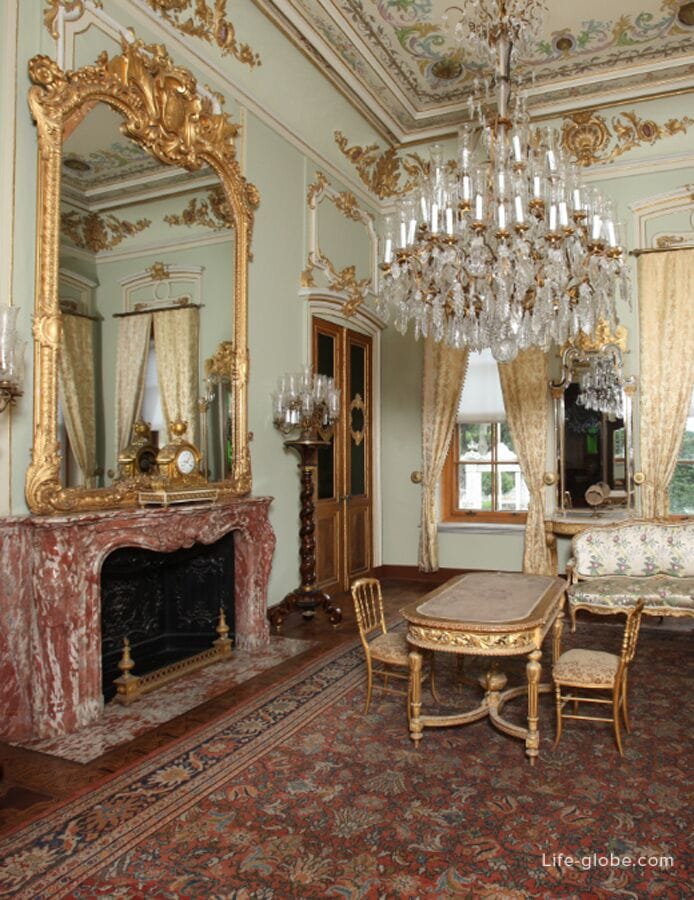
Other palaces, mansions and pavilions in Istanbul
Blachernae Palace
The Blachernae Palace or Tekfur Palace (Tekfur Sarayı, Tekfur sarayı) today is the remains of a former palace built for the son of the Byzantine emperor.
The Tekfur Palace was one of the palaces used by the emperors during the last period of Byzantine palaces. It was ideally positioned to protect the emperors from possible rebellion. The palace was also used as a workshop for the manufacture of glass and tiles during the Ottoman Empire. During the 57-year-old Latin invasion of Istanbul, the Tekfur Palace and almost all other imperial buildings around it were destroyed.
Today, part of the ruins of the palace have been restored, and are used as a museum with part of the walls, an interior room with an exposition, a courtyard, an elevator and an observation deck.
Entrance to the palace is paid.
The Blachernae Palace is located in the European part of Istanbul, in the Fatih district, at the address: Ayvansaray Mahallesi, Şişhane Caddesi, 34087 Fatih/Istanbul.
Website of the Blachernae Palace: tekfursarayi.istanbul.

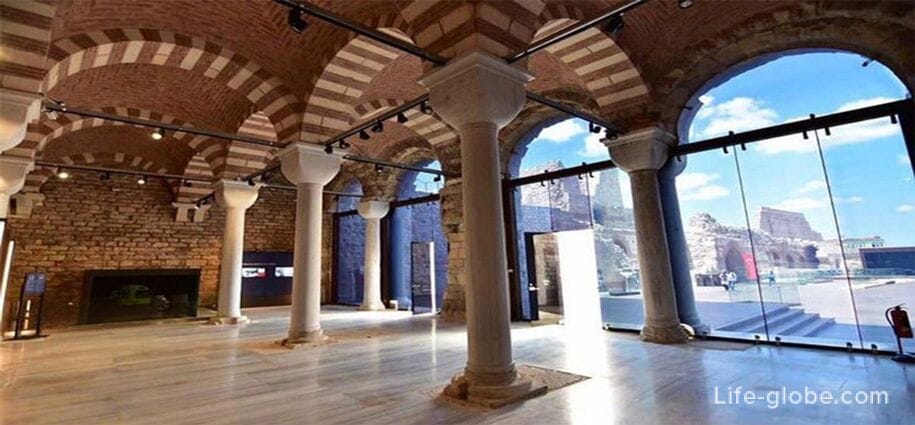
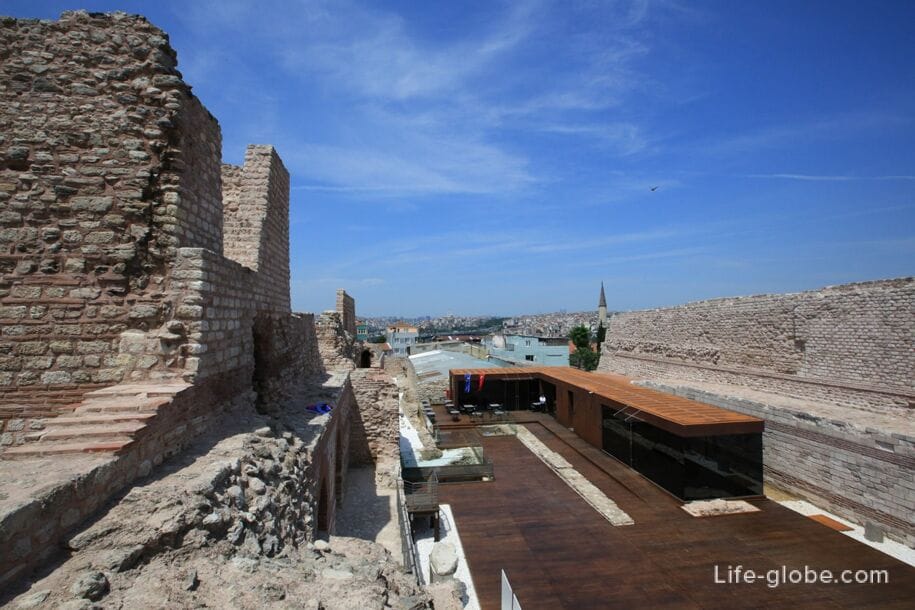
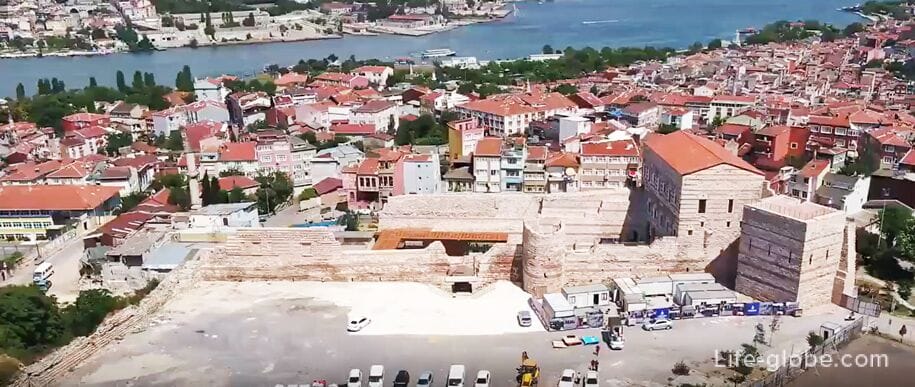
Museum of Mosaics of the Grand Palace
The Museum of Mosaics of the Grand Palace (Büyük Saray Mozaikleri Müzesi) is a museum of collections of mosaics from the time of the Byzantine Empire, discovered on the site of the Grand Imperial Palace of Constantinople.
Now there is no Grand Palace, but previously it was a huge palace complex that served as the main residence of the Byzantine emperors for eight hundred years (from 330 to 1081).
The Mosaic Museum is one of the largest and most diverse landscape images preserved since late antiquity. The mosaics, according to research, date back to a period somewhere between 450-650 years of our era. Most likely, the mosaics were created under the Byzantine emperor Justinian I, in the first half of the 6th century.
Entrance to the mosaic museum is paid.
The Mosaic Museum of the Grand Palace is located on the south side Blue Mosque; in the European part of Istanbul, at Sultanahmet Mahallesi Kabasakal Cad. Arasta Çarşısı Sok. No. 53, 34122 Fatih/Istanbul, Turkey. Log in from Arasta bazaar.
Website of the Grand Palace Mosaic Museum: muze.gov.tr/muze-detay. Learn more about the Grand Palace Mosaic Museum...
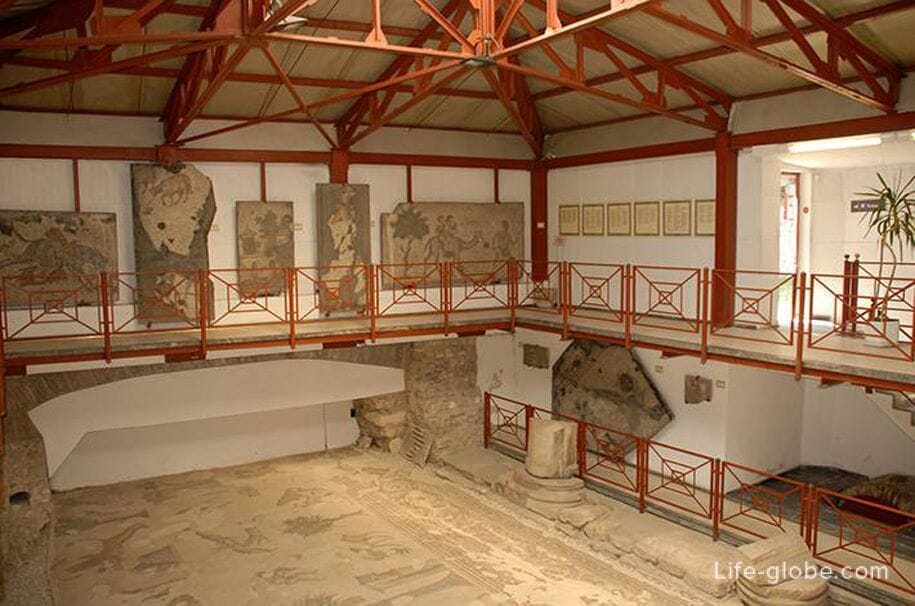

Ibrahim Pasha's Palace
Ibrahim Pasha Palace (Ibrahim Paşa Sarayı) is a monument of Ottoman architecture of the 16th century and the former residence of the Grand Vizier of the Ottoman Empire Pargala Ibrahim Pasha.
The palace got its name from Ibrahim Pasha of Pargali (1494-1536), the son-in–law and grand Vizier of Suleiman the Magnificent, who lived in it.
After the execution of Ibrahim Pasha, the palace was the residence of subsequent grand viziers. Later it housed an embassy, sewing workshops, a military band and a prison.
From 1938 to the present, the palace has housed the Museum of Turkish and Islamic Art (Türk ve Islam Eserleri Müzesi). The museum has several departments with a collection of exhibits of more than 40,000 units. These are collections of ceramics, sculptures, glass, wood, stone, metal, miniatures, masterpieces of calligraphy, historical documents, carpets with rare specimens, jewelry.
Entrance to the museum-palace is paid.
Ibrahim Pasha Palace is located in the center of the historic old part of Istanbul, on the most famous square of the city - Sultanahmet Square (Hippodrome), at the address: Binbirdirek Mahallesi, At Meydani Sokak, No: 12 Sultanahmet/Istanbul.
The museum's website: muze.gov.tr/muze-detay.
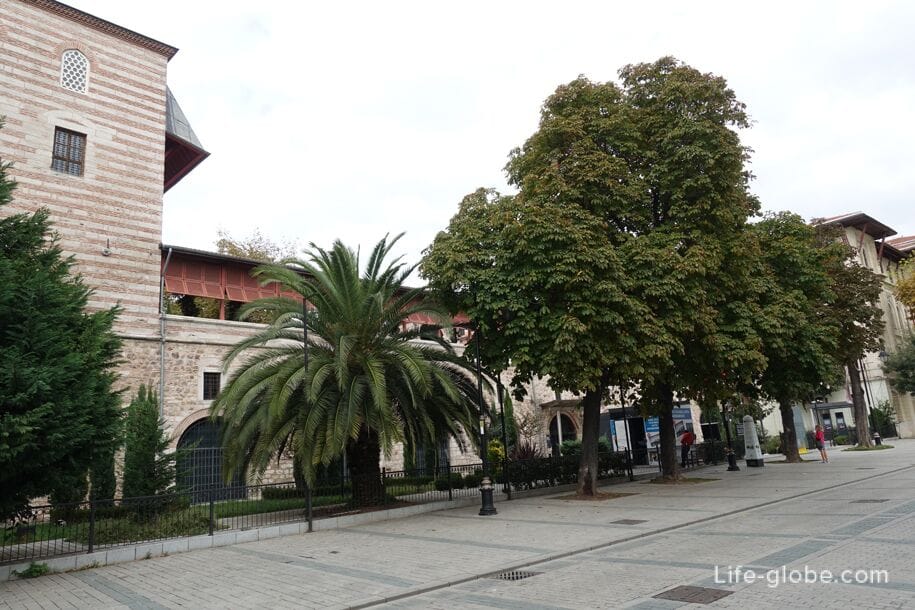

!!! In Topkapi, the Mosaic Museum of the Grand Palace, the Museum of Turkish and Islamic Art, as well as some other museums in Istanbul and in The Galata Tower with an observation deck has a museum map of Istanbul (Museum Pass Istanbul) and a museum and tourist map Istanbul E-pass. Learn more about museum and tourist maps of Istanbul...
Ruins of the Bucoleon Palace
Bukoleon Palace (Bukoleon sarayı) is a former palace of the Byzantine period dating from the reign of Theodosius II (5th century) and built near the waters of the Sea of Marmara.
Emperor Theophilus rebuilt and expanded the palace, adding a large facade on top of the walls facing the sea. In 969, Emperor Nikephoros II built a wall surrounding the palace complex. The Bucoleon remained the main palace of the Byzantine court until the 11th century, when the Komnenos dynasty built the Blachernae Palace in the suburb of Constantinople - Blachernae (now part of the city of Istanbul).
Today, small ruins with large arches and gardens remain from the palace. Not so long ago, the Istanbul Municipality announced that the palace will be restored and it is planned that it will become an open-air museum with a wooden walking path for visitors, a museum and a swimming pool.
The ruins of the Bucoleon Palace are located in the European part of Istanbul, near the waters of the Marmara Sea, at Sultan Ahmet, Kennedy Cd. No:40, 34122 Fatih/Istanbul, Turkey.
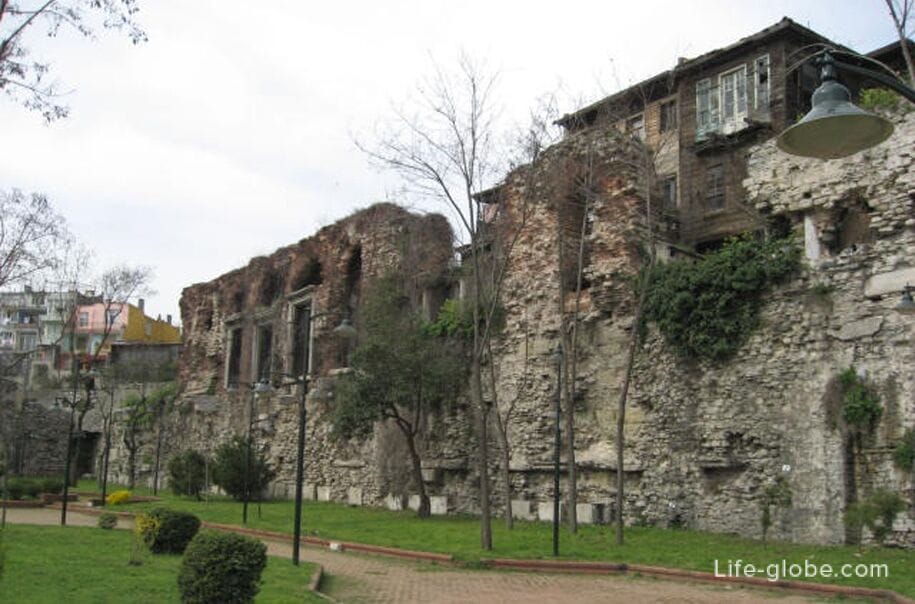
Ainaly Kavak
Aynaly Kavak (Aynalıkavak kasrı), which is also known as the shipyard Palace, is a summer pavilion that has been preserved from the Ottoman Sultan's palace complex and which was considered the fourth largest palace of the Ottoman Empire, after Topkapi, Dolmabahce and Beylerbeyi palaces.
According to some sources, the construction of structures began during the reign of Mehmed II the Conqueror. Another version says that the complex is identical to the reign of Suleiman the Magnificent. The palace complex included numerous buildings and gardens. Over the course of history, the buildings were supplemented until the complex was destroyed as part of Selim's innovative movements.
Today, the preserved (now restored) Ainalikavak pavilion is one of the most elegant legacies of classical Ottoman architecture that has survived to the present day, with its roof decorated with wide cornices, stylish ottomans in decoration, glazed dormer windows made by placing glass fragments in plaster carvings, and details reflecting all the tastes of the era.
Within the walls of the palace pavilion there is a museum with beautiful halls.
Entrance to the museum is paid.
The Ainalikavak Pavilion is located in the European part of Istanbul, near the Golden Horn Bay, at the address: Keçeci Piri, Donanma Cd., 34440 Beyoğlu/Istanbul, Turkey.
Museum website: aynalikavak-kasri.

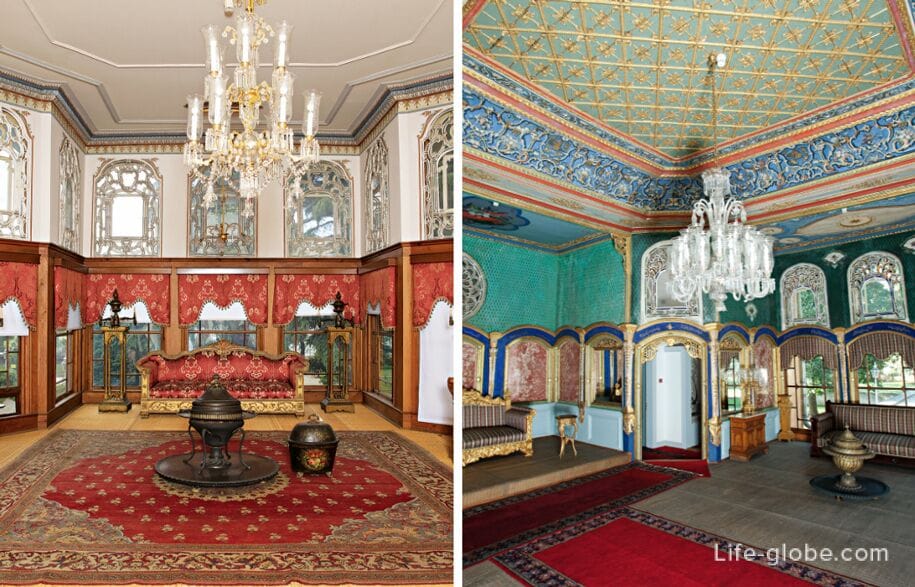
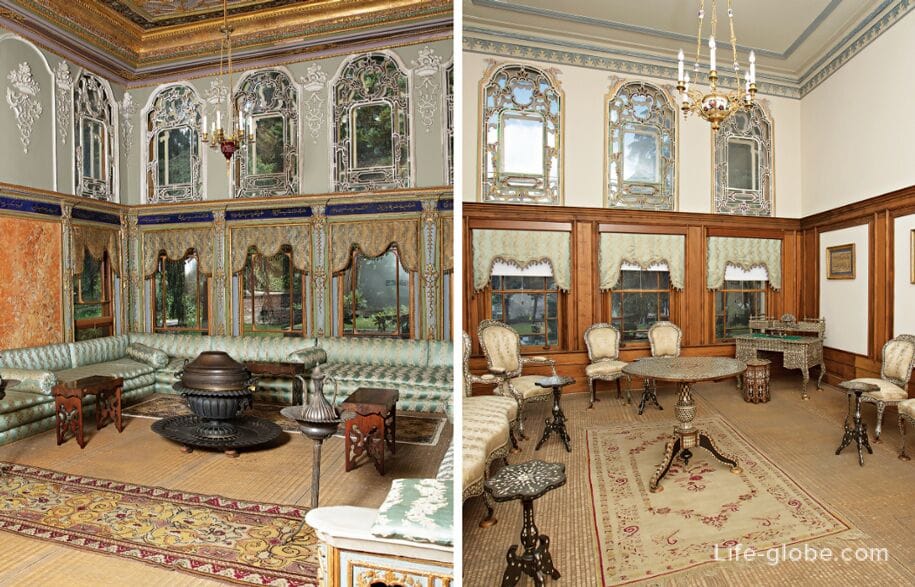
The Ylamur Complex
Ihlamur (Ihlamur Kasrı) is a former summer residence of the sultans of the Ottoman Empire, used for recreation, and built in 1849-1855 by order of Sultan Abdul-Majid I.
It was a small palace complex consisting of two buildings: a ceremonial or ceremonial (Merasim Köşkü, Merasim) and private chambers or harem (Maiyet Köşkü, Mayet).
Bright features and spectacular neo-Baroque decorations are visible in the architecture, which makes the complex one of the most elegant examples of Ottoman buildings of the 19th century.
Today it is a museum with a magnificent interior palace decoration with halls and rooms and the surrounding garden and forest area with a lake.
This place is often used for photo shoots.
Entrance to the park and museum is paid.
The palace is located in the European part of Istanbul, in the Nisantash district (Nişantaşı), at the address: Teşvikiye, Nişantaşı Ihlamur Yolu Sk., 34357 Şişli/Istanbul, Turkey.
Museum website: ihlamur-kasirlari.

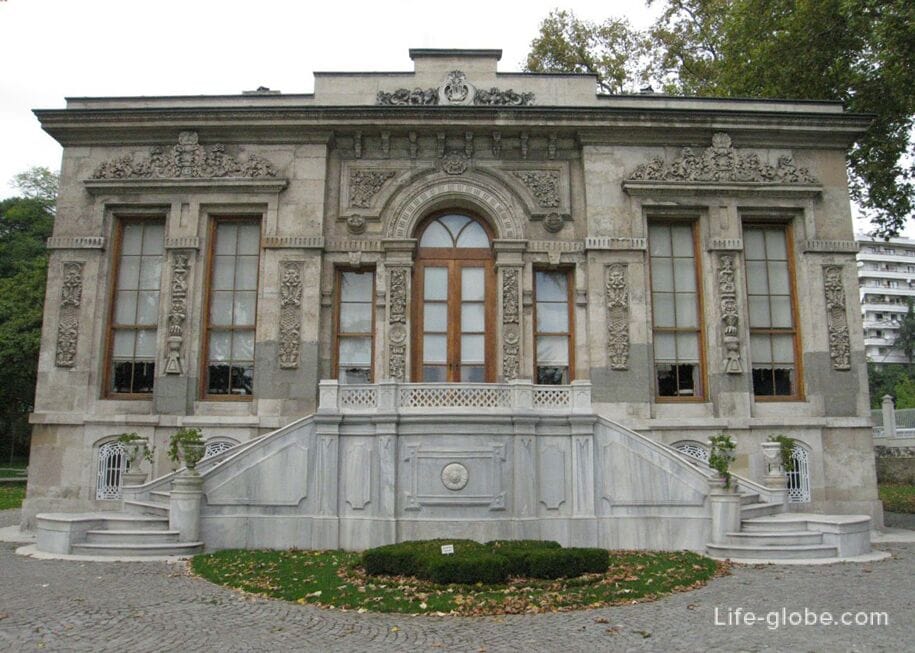
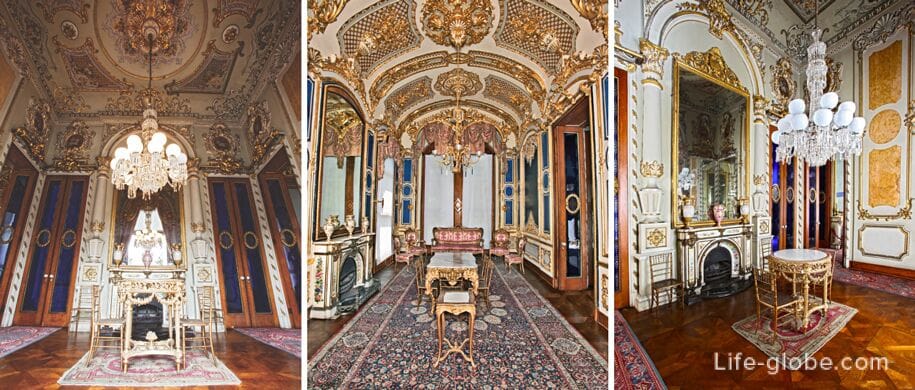
Yildiz Palace and Park Complex
Yıldız is a large Sultan's historical palace and park complex of the 19th century, which includes the palace of the same name and a park with pavilions, including the Malta Pavilion.
The Yildiz Palace (Yıldız Sarayı, which translates as "Star Palace") was first built by Sultan Selim III for his mother Mihrishah Sultan (Gyurju Gyuzeli).
The palace was used as the main palace of the Ottoman Empire during the reign of the last sovereign ruler of the Ottoman Empire - Sultan Abdulhamid II (since 1889), after the Sultan left the Dolmabahce Palace due to dramatic events and for security reasons.
Now the palace is used by the president (perhaps someday the palace will be reopened to visitors and then the palace can be classified as the best palaces in Istanbul; we recommend checking the information on the official websites).
Yildiz Palace website: yildiz-sale.
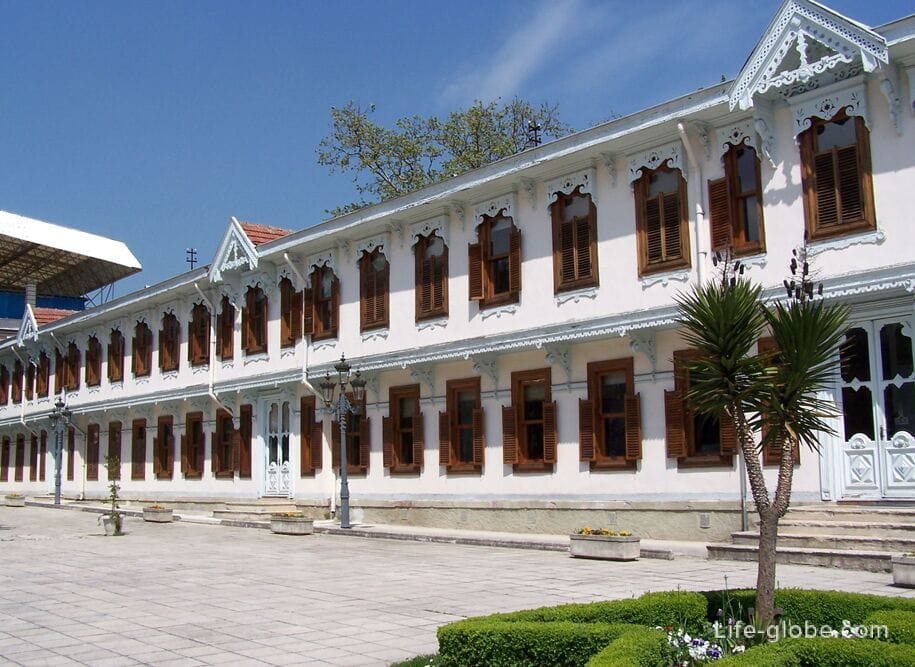
Near the Palace is Yildiz Yildiz Park (Yıldız Parkı), which formerly adjoined to the Palace and was part of the ensemble of the Palace, and today it is one of the largest public historical parks of Istanbul, and lush vegetation, historic pavilions, gazebos, children's and sports playgrounds, toilets, places for recreation and walks, ponds, artificial ponds, fountains, bridges, waterfalls, sculptures and cafes.
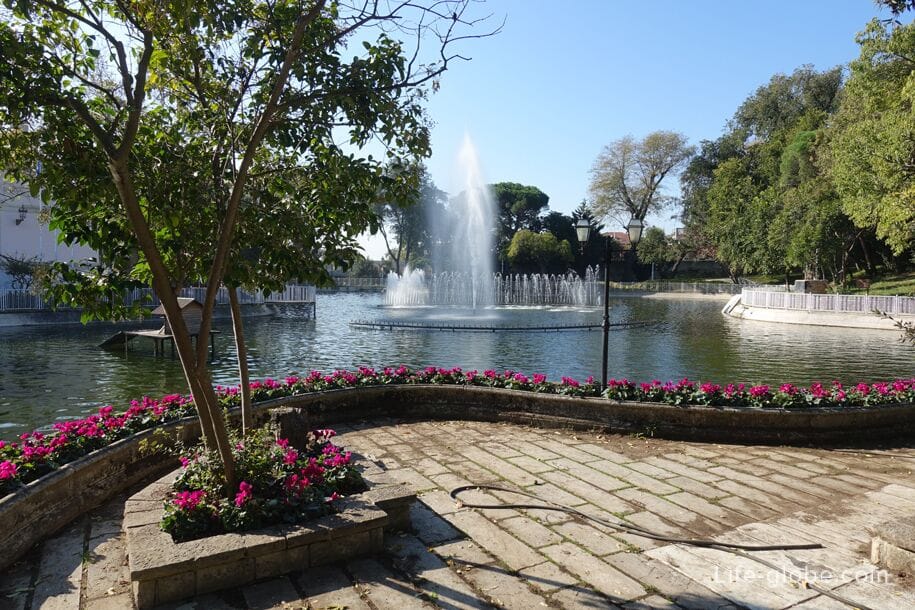
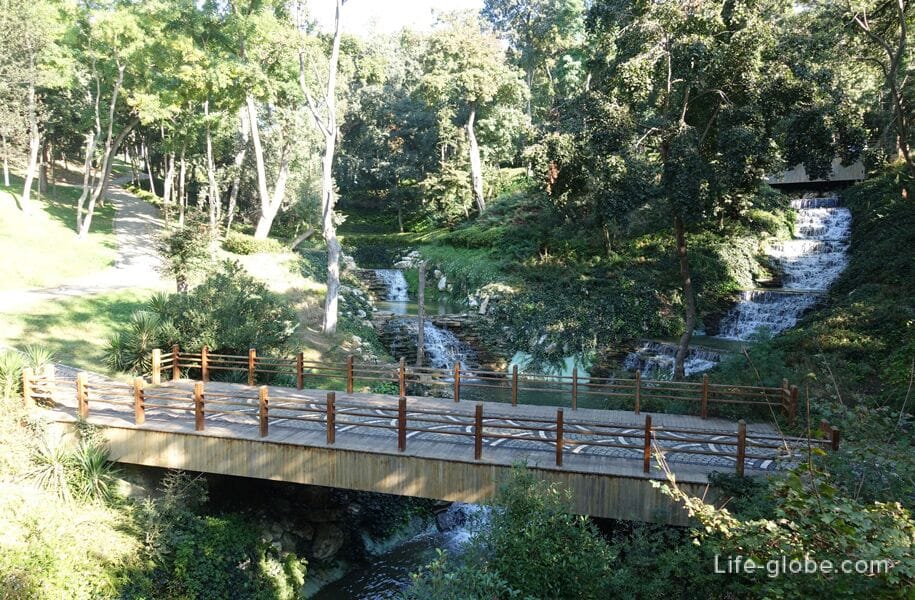
Among the buildings of Yildiz Park , the following stand out in particular:
- The Chadir Pavilion (Çadır Köşkü), built in 1871 at the request of Sultan Abdulaziz;
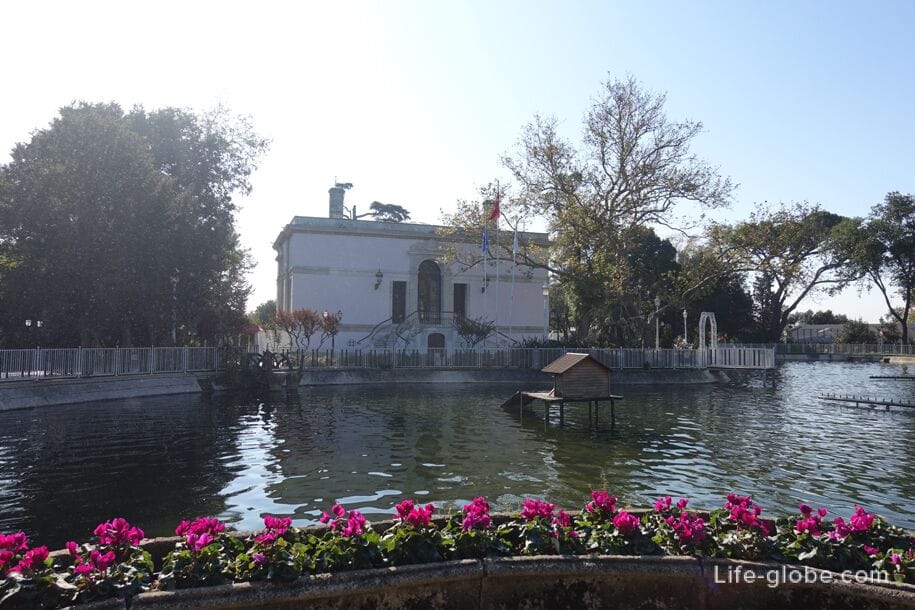
- Malta Pavilion or Maltese Pavilion (Malta Köşkü), which was designed by architect Sarkis Balyan and which now houses a cafe.
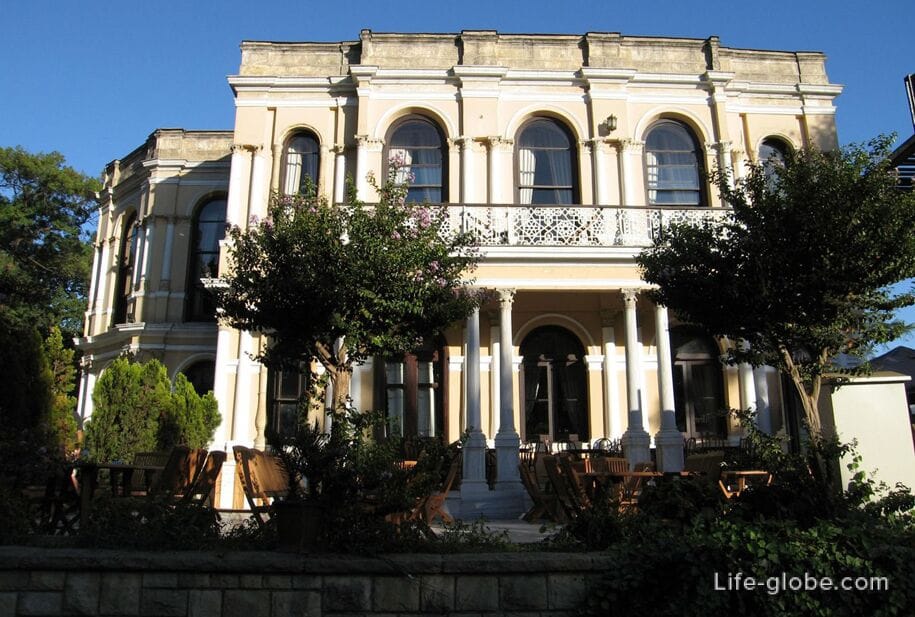
Entrance to Yildiz Park is free.
The Yildiz complex is located in the European part of Istanbul, in the Beşiktaş district, near the waters of the Bosphorus Strait. More about Yildiz Palace and Park...
Chiragan Palace
The Chiragan Palace (Çırağan Sarayı) is a former Ottoman palace located on the European side of Istanbul, in the Beşiktaş district, near the waters of the Bosphorus Strait, near the Yildiz Palace and Park complex.
Once there was a functioning bridge that connected the Yildiz Palace with the Chiragan Palace through the Yildiz Park.
The Chiragan Palace with the adjacent park was built between 1863 and 1872 by Sultan Abdul-Aziz.
Today in the restored palace and on the adjacent territory there is a beautiful (in the Baroque style) 5-The star hotel Çırağan Palace Kempinski Istanbul.
At the hotel: a territory with a garden and a panoramic pool overlooking the waters of the Bosphorus, a spa and wellness center, a fitness center, a restaurant, a bar, a lounge, a gazebo, a Turkish bath, free private parking and Wi-Fi.
The room rate includes: breakfast or breakfast + dinner. Link to the hotel
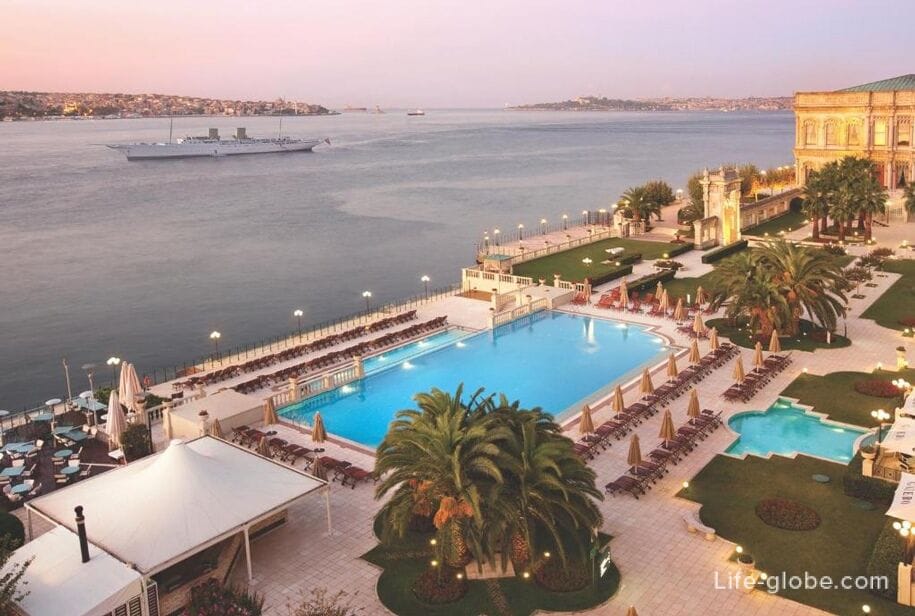
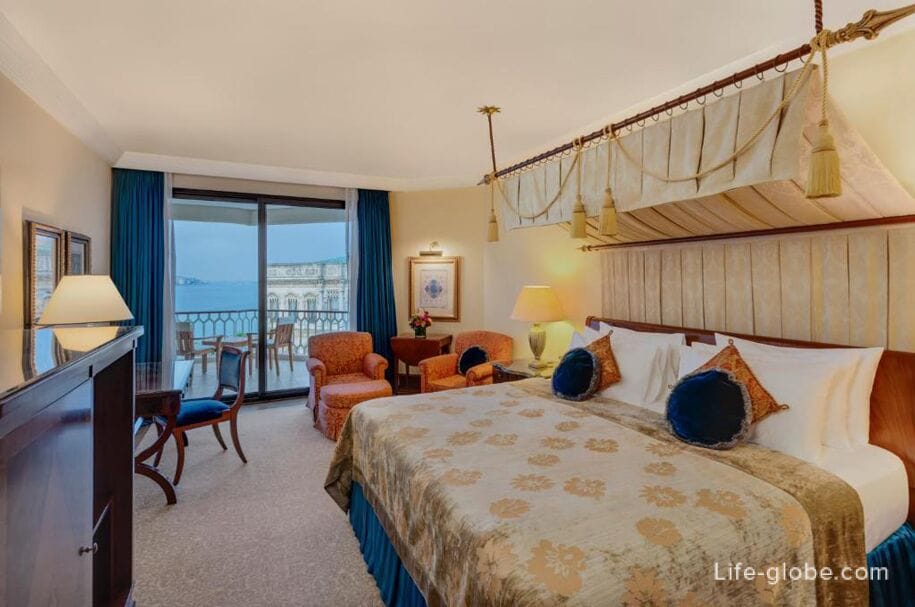
Ferie Palace
Feriye Sarayı Palace Complex is a former imperial palace complex, which has now been transformed into school and university buildings.
The Feriye Palace was built for the family of Sultan Abdul-Aziz by the famous architect Sarkis Balyan and commissioned in 1871. The palace was built for the needs of a large sultan's family as an addition to the Dolmabahce and Chiragan palaces. The palace was named "Ferie", which means secondary or auxiliary. The palace was a complex consisting of: three main buildings located on the Bosphorus embankment, a building for concubines, a two-story building for servants in the courtyard and outbuildings.
On May 30, 1876, Sultan Abdul-Aziz was deposed from the throne by his ministers, after which, together with his wives and children, he was imprisoned as a state criminal. The Sultan voluntarily moved to the Feriye Palace, however, four days later he was found dead and was believed to have committed suicide. After the death of Abdul-Aziz and even after the abdication of the next sultan, when they received freedom, the family of Abdul-Aziz continued to live in this palace.
Subsequently, the palace buildings were empty, then they were restored and transferred to educational institutions and various administrative offices.
Today, educational institutions and a restaurant are located in the buildings of the former palace.
The palace is located near the waters of the Bosphorus in the Ortakoy area.
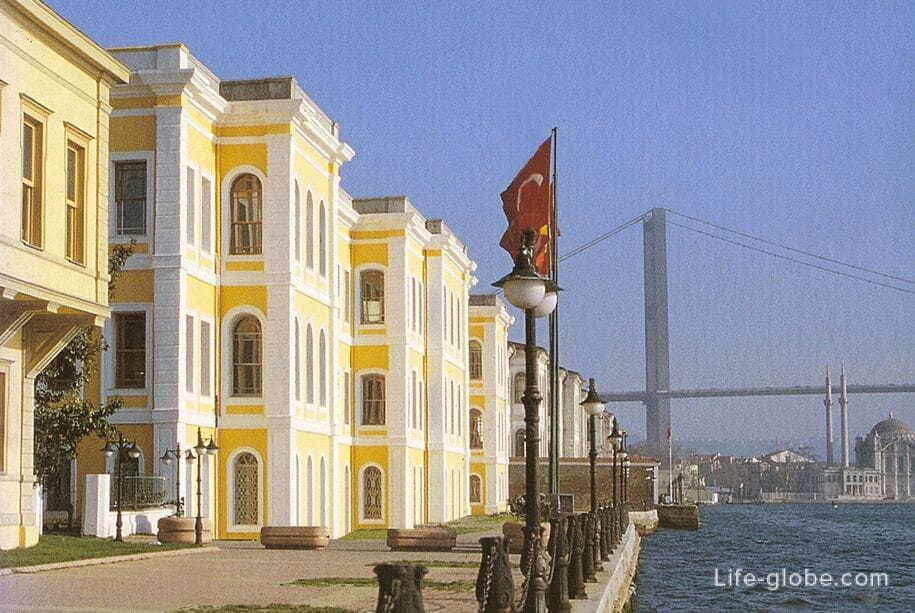
Esma Sultan Palace
Esma Sultan Palace (Esma Sultan kasrı) is the former mansion of one of the daughters of the 32nd Ottoman Sultan Abdulaziz I - Esma, who received the palace as a wedding gift in 1889.
The mansion remained in the possession of the Ottoman dynasty until 1915. Subsequently, the building was used first as a tobacco warehouse, and then as a coal warehouse, which was destroyed by fire in 1975.
The ruins, consisting only of the exterior walls of the building, were acquired in the early 1990s by the Marmara hotel chain. After reconstruction with additions, the mansion was opened as a multifunctional event venue.
Receptions, weddings and celebrations are now taking place in the building and on the adjacent territory. The name of the pavilion is "The Marmara Esma Sultan". Website: esma-sultan.
The pavilion is located in the European part of Istanbul, in the Ortakoy quarter, near the waters of the Bosphorus, at the address: Yıldız, Muallim Naci Cad. & Yalı Çıkmazı No:20, 34347 Beşiktaş/Istanbul, Turkey.

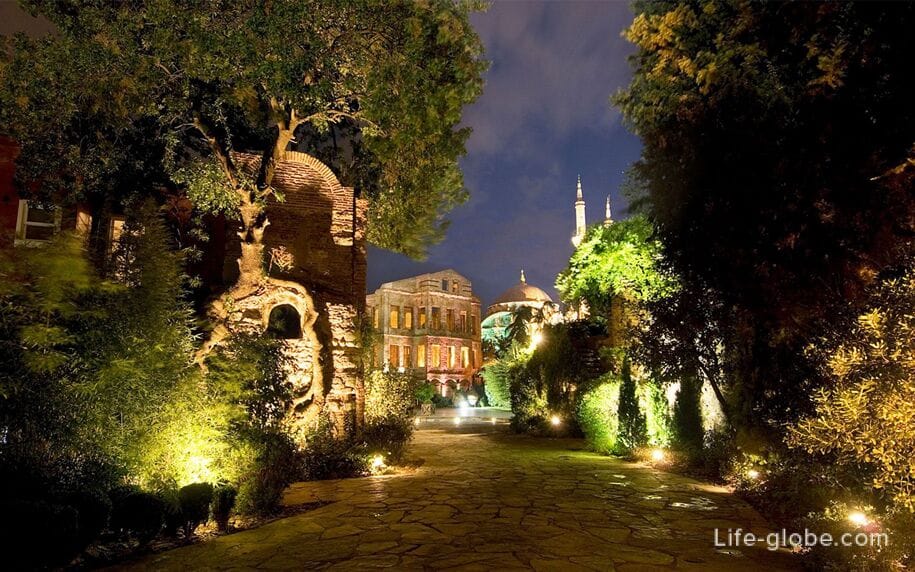
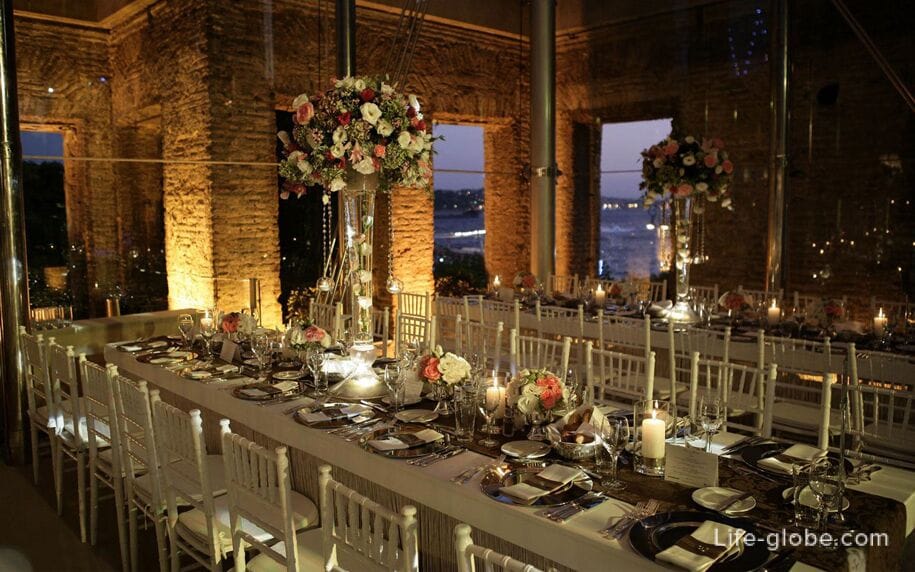
In the Ortakoy area there is also a former historical coastal mansion of Hatice Sultan (Hatice Sultan Yalısı), named after its original owner Hatice Sultan, who was an Ottoman princess, daughter of Sultan Mustafa III and his wife Adilshah Kadin, also a half-sister of Sultan Selim III.
Maslak Pavilions
Maslak (Maslak Kasırları) is a former palace complex consisting of a garden and pavilions, and was used as a hunting residence and a resting place of the sultans of the Ottoman Empire.
The palace complex was built under Sultan Mahmud II, and various additions, including buildings, were made during the reign of Sultan Abdul-Aziz.
Some of the structures of the palace complex have survived to the present day, while others have been demolished.
Among the many buildings of the complex, only Mabeyn-i Humayun, Kasrsi Humayun, Limonluk Kulkhani, Agalar's Office and a Tent Villa have survived to this day.
Today it is a museum with a cafe and a restaurant.
Entrance to the museum is paid.
Maslak Pavilions are located in the European part of Istanbul, in the Sarıyer district on the Maslak-tepesi hill, at the address: Darüşşafaka, Büyükdere Cd., 34398 Sarıyer/Istanbul, Turkey.
Maslak Pavilion Museum website: maslak-kasirlari.
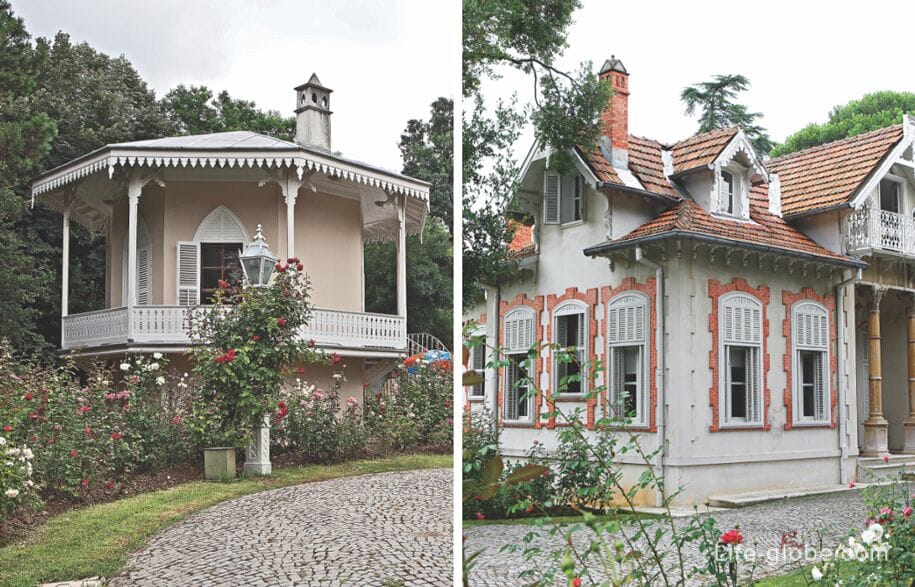


Adile Sultan Palace
Adile Sultan Palace (Adile Sultan kasrı) is a former imperial residence built in the second half of the 19th century by decree of Sultan Abdulaziz for his younger sister Adile Sultan.
Now the palace has been restored and is a cultural and educational center, where conferences, banquets and weddings are also held.
The pavilion is located in the Asian part of Istanbul, in Usküdar district (Üsküdar), at: Barbaros, Tophanelioğlu Cd. No:72, 34662 Üsküdar/Istanbul, Turkey.

Avraham Pasha Pavilion (Beykoz Glass and Crystal Museum)
Today's Beykoz Glass and Crystal Museum (Beykoz Cam ve Billur Müzesi) is located in a restored historical barn building of the former residence of Abraham Pasha, who was a confidant of the Egyptian Khedive Ismail Pasha and received the title of vizier from Sultan Abdulaziz.
The building, bearing the architectural features of the 19th century, is a modular structure based on the duplication of similar spaces surrounding the courtyard in a U-shape, and its facades are enlivened by round arched openings on the lower floor. The building houses museum spaces with masonry and a Western-style structure, where developments of Turkish and European glass, porcelain and crystal are presented in 12 sections.
Entrance to the museum is paid.
The museum is located in the Asian part of Istanbul, at the address: Merkez, Mehmet Yavuz Cd. No:115, 34820 Beykoz/Istanbul, Turkey.
Website of the Museum of Glass and Crystal: beykoz-cam-ve-billur-muzesi.
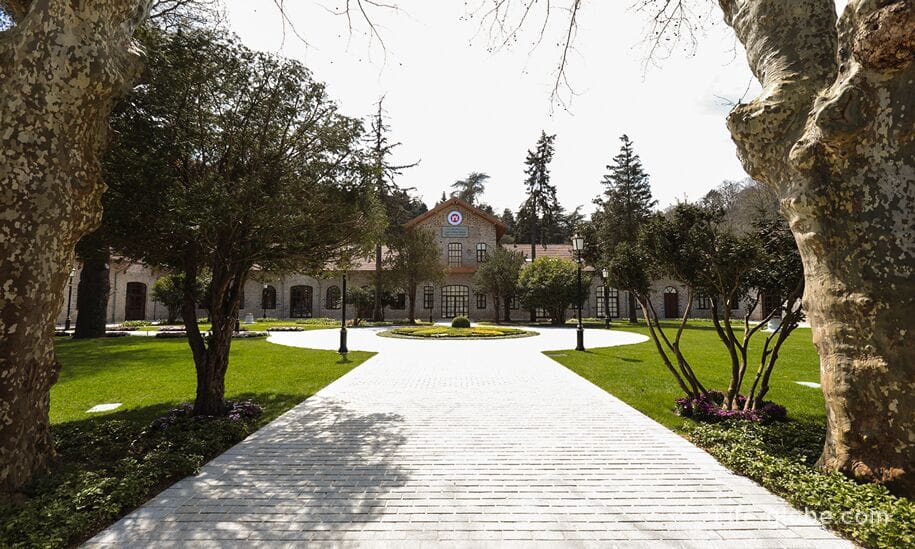
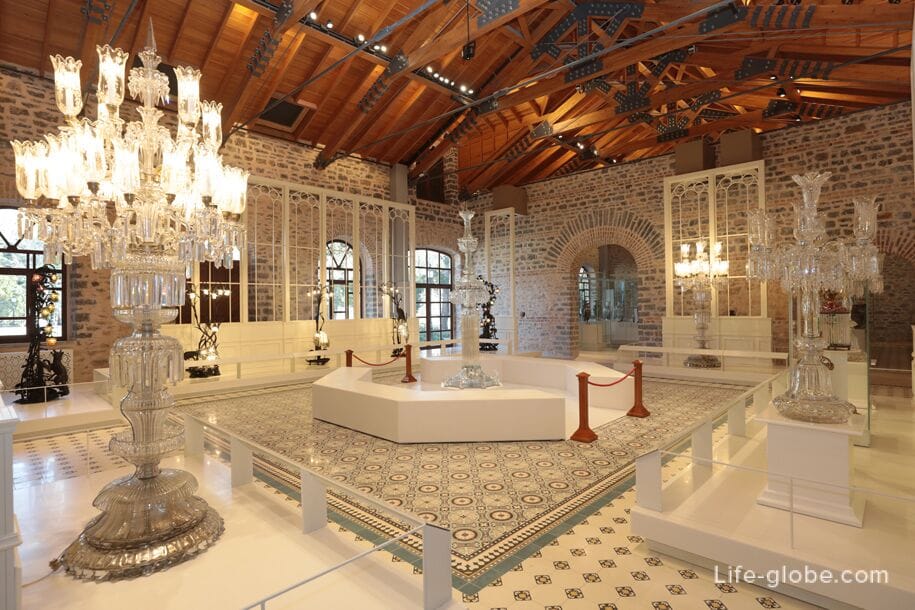

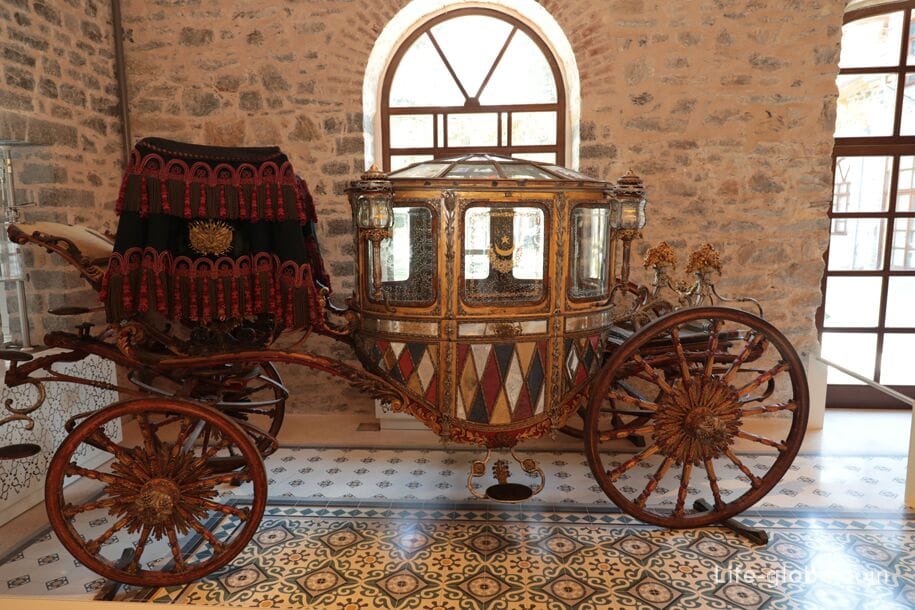
Hidiv Pavilion
The Hidiv Pavilion (Hidiv köşkü) was built in the Art Nouveau style in 1907 by the last Khedive of Egypt, Abbas Hilmi Pasha.
The second name of the pavilion is "Chubuklu Palace".
The building has an Art Nouveau style with a tower overlooking the Bosphorus. In the center of the main entrance there is also a monumental marble fountain.
Today the pavilion has been restored and is surrounded by a garden. It is used as a restaurant for celebrations and a social institution. Website: hidiv-kasri.
The pavilion is located in the Asian part of Istanbul, at the address: ubuklu Mahallesi, Hıdiv Kasrı Caddesi No:1/1 Çubuklu - Beykoz /Istanbul.

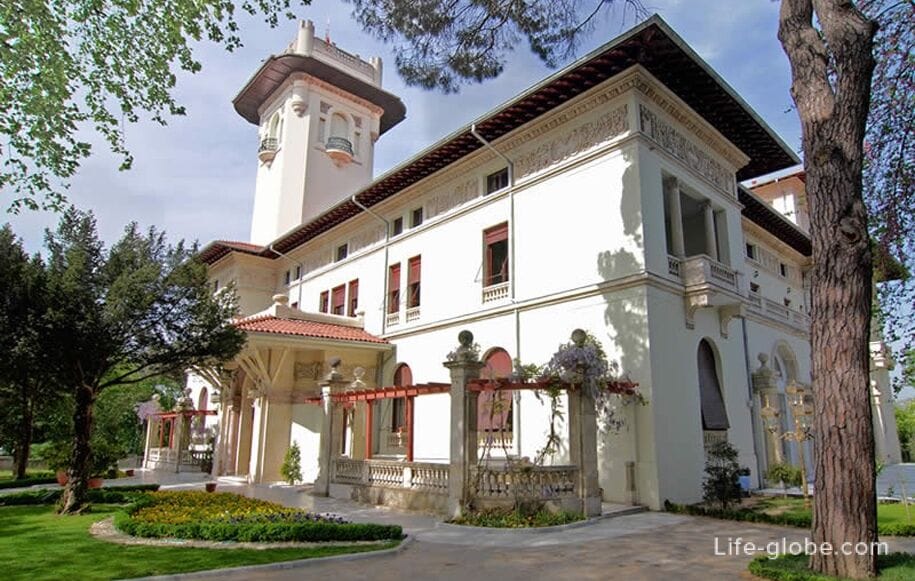
Beykoz Medjidie Mansion
Beykoz Medjidiye Mansion or Beykoz Palace (Beykoz Mecidiye Kasrı) is one of the oldest pavilions in Istanbul.
The construction of the pavilion, which was started by the Egyptian Governor Mehmed Ali Pasha as a gift to Sultan Abdul-Majid in 1845, was continued during the reign of his son, the Egyptian governor Said Pasha, after the death of Mehmed Ali Pasha in 1849. The complete construction was completed in 1854.
The Medjidiye Pavilion was not very popular with Sultan Abdul-Medjid, but it was often visited by Sultan Abdulaziz, especially in the summer months. The pavilion was used during sultan's hunts, as well as for daily living and official receptions. The Sultan received the French Empress Eugenie here on October 15, 1869 and together with her watched the army parade from the pavilion.
Today, this two-storey pavilion is a museum and one of the most elegant historical mansions in the city. The mansion is located in surrounded by groves with terraces, magnolias, pines and lime trees. From the territory of the palace park there are views of the Bosphorus.
The pavilion with the park is located in the Asian part of Istanbul, near the waters of the Bosphorus, in the Beykoz district, at the address: Yalıköy, Beykoz Kasrı, 34820 Beykoz/Istanbul, Turkey.
Beykoz Museum website: beykoz-mecidiye-kasri.



The mansion of the first President of Turkey
The mansion of the first President of Turkey, Ataturk, can also be included in the list of significant mansions in Istanbul.
The mansion which bears the name "Ataturk's Seaside Pavilion in Florya" (Florya Ataturk Deniz Köşkü).
This is a historical presidential residence, which was built in 1935 by the Istanbul Municipality for the recreation of Mustafa Kemal Ataturk.
Today this building is a historical house-museum, where furniture, dishes, personal belongings, as well as a collection of photographs of Ataturk taken at this place are presented.
Entrance to the museum is paid.
The mansion is located in the European part of Istanbul, on the shore of the Marmara Sea, in the Floria district, at the address: Basınköy, Çekmece Istanbul Cd. No:23, 34153 Bakırköy/Istanbul, Turkey.
Website: florya-ataturk-deniz-kosku-nerede-nasil-gidilir-giris-ucreti.

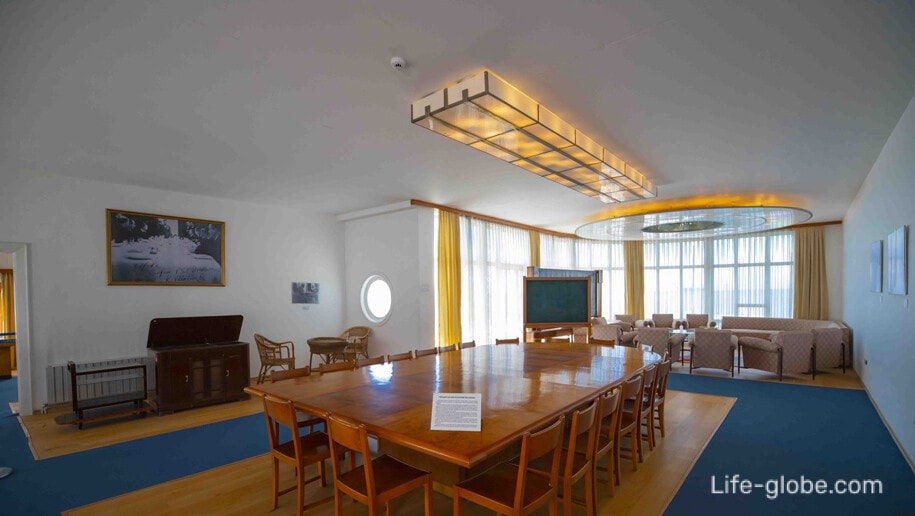
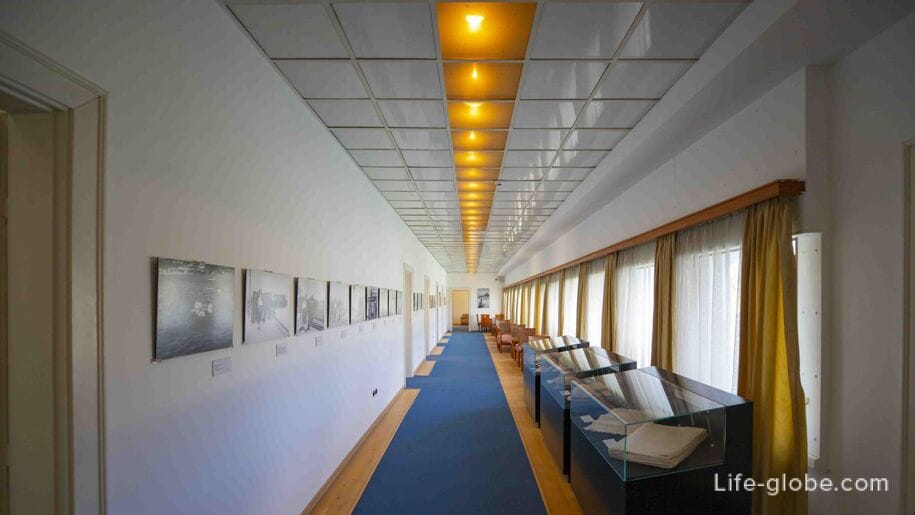
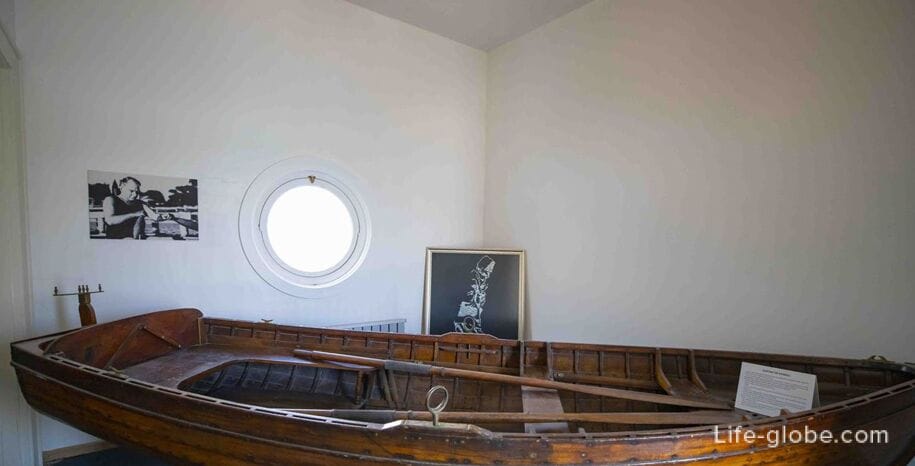
All accommodation facilities in Istanbul, including in the historical center, on the European and Asian sides of the city, can be viewed and booked here








